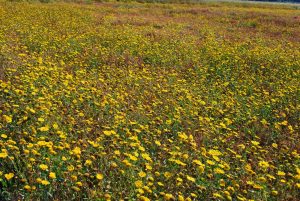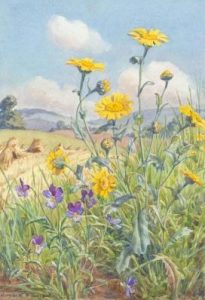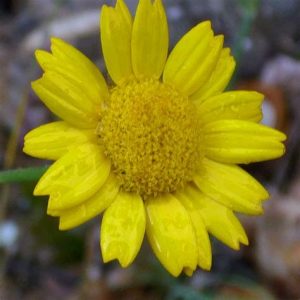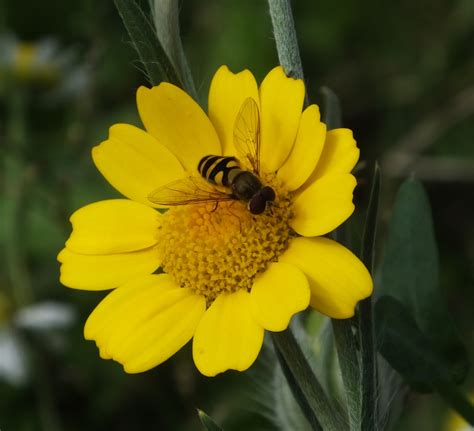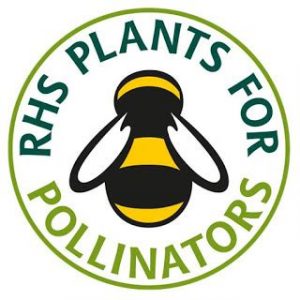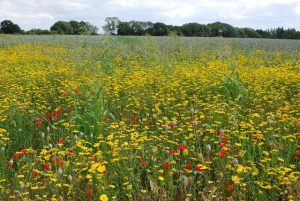CORN MARIGOLD (Chrysanthemum / Glebionis segetum)
Western Asia, Mediterranean
Chrysanthemum segetum’s large GOLDEN YELLOW flower discs are borne singly on the ends of its stems. Leaves are deeply toothed & greenish-blue with a waxy bloom. This is an aromatic plant giving off an apple-like aroma when leaves are rubbed together. It blooms from June to October.
Chrysanthemum is from the Greek ‘chrysos’ meaning ‘gold’ and ‘anthemom’ meaning ‘flower’. A field of Corn Marigold does look like a field of gold.
Corn Marigold is found on grassland, farmland, disturbed sites – rubbish tips, road verges & waste ground.
The plant thrives in sunny situations, but can tolerate light shade. It adapts to a wide variety of soil types including poor soils – clay, loam, sand – but dislikes lime or wet conditions. Moist but well drained is best. Sow seed in spring directly where plants are to flower. Autumn-sown plants rarely survive the winter PLANTLIFE
Walk on the Wild Side Helen Bostock, from RHS Gardening Advice, chooses 5 mixes of wildflowers & cultivated flowers & shows how best to combine Corn Marigold with other flowers. https://www.rhs.org.uk/plants/articles/misc/wildflower-combinations
John Parkinson, in his 1640 Theatrum Botanicum, described the use of Corn Marigold in midummer garlands and being hung up on houses. It was a familiar sight in 16th century English gardens.
PLANTLIFE
Historical
Corn Marigold is an ancient wildflower. Introduced into the UK before the Iron Age, this former cornfield weed is now listed as ‘vulnerable,’ as of 2005. Seed cleaning, liming and herbicides are thought to have been responsible. ‘Once abundant in cornfields throughout Britain, it is not a true native, but was probably introduced in ancient times with grain. It has been found in Scottish neolithic deposits and so probably arrived with the neolithic introduction of agriculture’. PLANTLIFE
It has been found, with corncockle, as cereal crop weeds in upper palaeozoic excavations. indigo.ie > -skerries > history > holmweed.html, Townland Study, Dublin Naturalists Field Club
Today’s gardener can appreciate the bright yellow flowers and blue-green foliage of the Corn Marigold more than the medieval farmer, who was penalised when Chrysanthemum segetum was found in a field of corn or grain.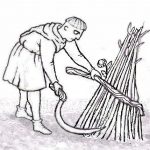
There were laws in Scotland and Denmark that obliged farmers to root out the weed.
In Scotland in the 13th century, according to a law of Alexander II, any farmer allowing so much as a single plant to reproduce seed among his crops would be fined one sheep.
…’an yll wede, and groweth commonlye in barleye and pees.’ Sir Anthony Fitzherbert, ‘Boke of Husbandrie’, 1523
Edible
Petals of Corn Marigold were churned into butter & added to cheese to intensify the yellow colour.
Young shoots are eaten as a vegetable in the East, particularly in China.
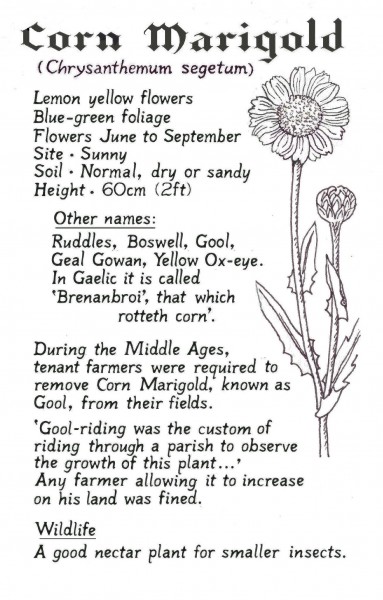
Bees Favourite
Corn Marigold is a good plant for bees, butterflies and moths. It is the food plant of the Chamomile Shark Moth.’ Now designated PERFECT FOR POLLINATORS by the RHS.
Seeds can be bought online : http://www.wildflowershop.co.uk/
https://www.growwilduk.com/content/know-your-wild-flowers
Diverse gardens is a website that looks at sowing corn marigold with other cornfield annuals – corn poppy, cornflower, corn cockle & corn chamomile, as part of a wildflower meadow in your own garden. It concentrates on bees & other key pollinators.
Corn Marigold
This website looks at why Corn Marigold was such a successful weed, its prolific creation of seeds (176 per seedhead, 1,000 to 2,000 per flower) & their survival. https://portal.gardenorganic.org.uk/weeds/corn-marigold HDRA, Ryton Organic Gardens, Coventry
Highbury
We have had it here for a season, grown from a wildflower seed mix with its cornfield companions, BLUE Cornflower, LAVENDER Corncockle and RED Field Poppy. Any seeds it may have produced were eaten by our wildlife.
Other names: Bigold, Big gold, Boodle, Buddle, Field marigold, Gill Gowan, Golden cornflower, Goldes, Goldings, Goldins, Golds, Guild Weed, Gule Gowan, Harvest Flower, Marybuds, Mary Buds, Wild Marigold, Yellow Boy, Yellowby, Yellow Cornflower, Yellow Daisy.

